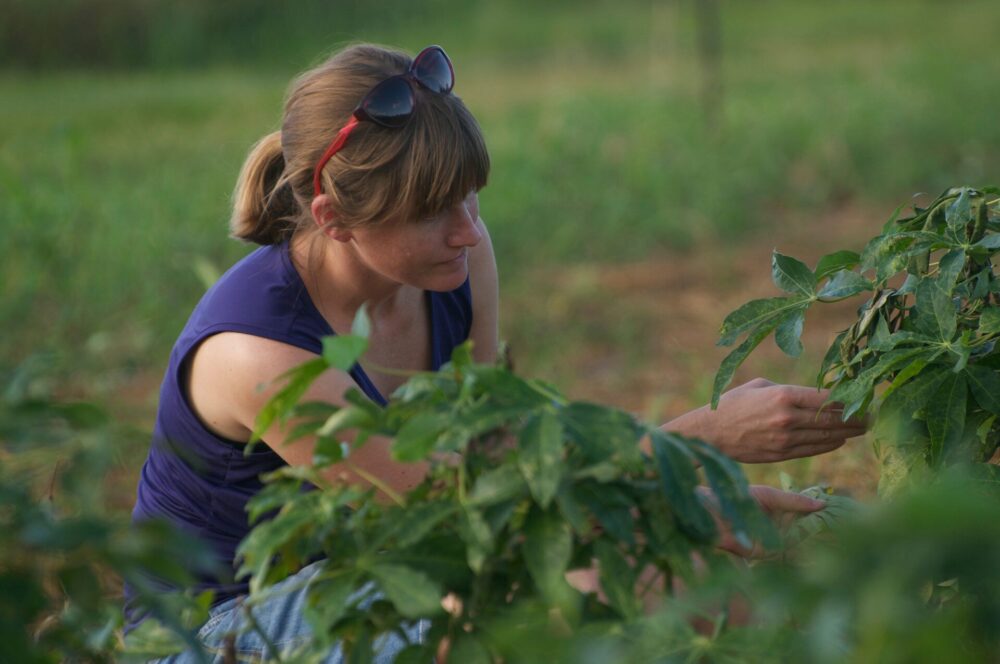Sometimes called “the drought, war and famine crop,” cassava is a staple food for roughly half a billion people around the world. Grown in tropical regions that are often vulnerable to the impacts of climate change, the cassava plant offers a level of food security thanks to its ability to thrive amid poor soils, droughts, and erratic rainfalls.
Global production of cassava has doubled since the start of the 1990s, and it’s now Africa’s most-produced cash crop as well as an important staple for parts of Latin America and Southeast Asia.
However, it’s also highly susceptible to Cassava Bacterial Blight (CBB), a disease with devastating potential to wipe out crop yields and deplete farmers’ incomes in the process.
“Cassava is an incredibly important food security crop for so many people,” scientist and researcher Rebecca Bart tells AFN. “But it also hasn’t really been studied intensively the way maize or crops have, so there’s so much to learn.”
Bart is a principal investigator at the Donald Danforth Plant Science Center in St. Louis, Missouri. She along with collaborators at the University of California at Los Angeles and the University of Hawaii at Manoa recently demonstrated that epigenome editing can reduce CBB symptoms in cassava plants without impacting plant growth or yield.
This work was supported by a grant from the Bill & Melinda Gates Foundation, funding from the National Science Foundation Graduate Research Fellowship Program, and funding from Washington University in St. Louis through the William H. Danforth Plant Sciences Fellowship.
It likely has applications beyond cassava, too.
“We would definitely expect this technology to get used for improving other crops like maize and rice and tomato and cotton,” says Bart.
Epigenetics
CBB is caused by the bacterium Xanthomonas phaseoli pv. manihotis (Xpm).
Bart’s lab specializes in the study of how hosts and pathogens interact. This most recent research, published in Nature Communications, focuses on increasing cassava resistance to this pathogen through epigenome editing. Epigenetics, she says, are “processes that affect gene expression without actually changing the DNA.”
“One of the strategies used by pathogens is to affect gene expression inside their hosts for their own benefit,” says Bart.
In cassava, the pathogen relies on the expression of host susceptibility (S) genes to increase the spread the Xpm. It does this by inducing the S genes to pump sugar into the space between cells, where the bacteria resides. Bacteria can then feed off the sugars and spread through the plant’s vascular system, which is responsible for transporting water and nutrients in the plant.
The strategy is common amongst pathogens attacking crops, from cassava to cotton and numerous others.
Bart and her team have developed a way to essentially protect the genes inside the plant using a biochemical process called “targeted methylation.” This involves transferring methyl groups to certain segments of DNA, and this protects the DNA from the pathogen.
“We know the genes in the cassava plant that the pathogen is targeting,” she says. “What we’re doing with our targeted methylation is introducing targeted methyl groups so that they are physically blocking the DNA, so that the pathogen can’t access those genes anymore. In this way, the pathogen can’t induce the S gene.”
As the research notes, one highly important point of Bart’s method is that it can reduce CBB symptoms in cassava plants without impacting plant growth and development.
Cassava first
The Gates Foundation originally matched Bart’s lab at Danforth Center with Steve Jacobsen’s at UCLA. Jacobsen has researched methylation and epigenetics for decades, including targeted epigenetic editing on the model plant Arabidopsis. Jacobsen is also the scientific co-founder of seed gene-editing startup Inari.
“His lab and other labs have really studied the processes that control methylation over many, many years.,” explains Bart. “We’ve been collaborating together for six or seven years, trying to take what the Jacobsen lab has studied and transfer it over to cassava,” she says.
“Normally with a crop like cassava, we’re playing catch up, taking the technologies that have already been successfully applied to other crops and seeing if we can make them work in cassava, too. In this case, it was a really fun twist of having the resources to do a demonstration in cassava first.”
From sledgehammer to sensitivity
“One of the things I’m most excited about for this technology is that it provides an opportunity to be much more nuanced in the changes we make to plants,” says Bart.
Bart and her team are among those hoping to further expand the applications and range of changes that can be made through methods like gene editing.
“Especially thinking about climate change and protecting our crops from abiotic stresses, we have the ability to more gently and sensitively fine-tune gene expression to find the right balance. Or we can trigger a certain response only in the presence of a certain stress instead of this “all or nothing” hammer that we’ve used in the past.
Bart says it could be possible to detach the process from the traditional transgenic approach it currently uses.
“The team uses a standard transgenic approach, which typically involves introducing novel DNA sequences into the plant,” she says. “We use a type of bacteria, called Agrobacterium, to deliver the DNA into the cassava plant cells. However, once the targeted methylation is achieved, the novel DNA sequences can be removed such that only the change in the epigenome remains.”
Her lab hasn’t yet demonstrated this, but “it’s easy to envision how that could be done in the future.”
“There’s nothing in my opinion inherently wrong with genetic engineering and transgenics. But the more tools we can have in our toolbox, the better,” she says. “It’s easy to speculate ways in which you might be able to use epigenome editing to achieve an outcome that is possible through traditional transgenics. It’s another tool in the tool belt.”




